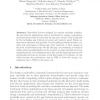Free Online Productivity Tools
i2Speak
i2Symbol
i2OCR
iTex2Img
iWeb2Print
iWeb2Shot
i2Type
iPdf2Split
iPdf2Merge
i2Bopomofo
i2Arabic
i2Style
i2Image
i2PDF
iLatex2Rtf
Sci2ools
PATMOS
2005
Springer
2005
Springer
Improving the Memory Bandwidth Utilization Using Loop Transformations
Abstract. Embedded devices designed for various real-time multimedia and telecom applications, have a bottleneck in energy consumption and performance that becomes day by day more crucial. This is imposed by the increasing gap between processor and memory speed. Many authors have addressed this problem, but all existing techniques either consider only performance without any other trade-off, or they operate at the level of individual loops. We fill this gap, by presenting a technique which achieves parallelization in the memory accesses through four loop transformations. Our estimations from two real-life applications from the multimedia and telecom domain, reveal that using our technique, we can either increase the performance (up to 35%) or lower the energy consumption (up to 20%) for the same cost.
Related Content
| Added | 28 Jun 2010 |
| Updated | 28 Jun 2010 |
| Type | Conference |
| Year | 2005 |
| Where | PATMOS |
| Authors | Minas Dasygenis, Erik Brockmeyer, Francky Catthoor, Dimitrios Soudris, Antonios Thanailakis |
Comments (0)

